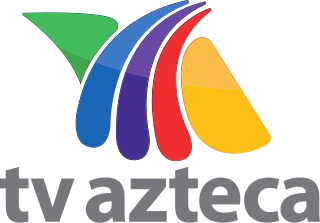Telecommunication in Honduras started in 1876 when the first telegraph was introduced, continued development with the telephone in 1891, radio in 1928, television in 1959, the Internet in the early 1990s, and cellphones in 1996.

Televisión Azteca, S.A.B. de C.V., commonly known as TV Azteca, is a Mexican multimedia conglomerate owned by Grupo Salinas. It is the second-largest mass media company in Mexico after Televisa. It primarily competes with Televisa as well as some local operators. It owns two national television networks, Azteca Uno and Azteca 7, and operates two other nationally distributed services, adn40 and A Más+. All three of these networks have transmitters in most major and minor cities.

Ricardo Benjamín Salinas Pliego is a Mexican businessman, founder and chairman of Grupo Salinas, a corporate conglomerate with interests in telecommunications, media, financial services, and retail.

Grupo Televisa, S.A.B., simply known as Televisa, is a Mexican telecommunications and broadcasting company. A major Latin American mass media corporation, it often presents itself as the largest producer of Spanish-language content.

Cable News Network en Español is a Pan-American Spanish-language news channel, owned by CNN Worldwide, a news division for Warner Bros. Discovery. It was launched on pay television, on March 17, 1997.

KYAZ is a television station licensed to Katy, Texas, United States, serving as the Houston area outlet for the classic television network MeTV. Owned and operated by Weigel Broadcasting, the station maintains studios at One Arena Place on Bissonnet Street on Houston's southwest side, and its transmitter is located near Missouri City, Texas.
XHAS-TDT is a television station in Tijuana, Baja California, Mexico, carrying Canal 66. It is owned by a Mexican company whose largest single investor is Entravision Communications, a U.S.-based broadcaster with radio and television stations in San Diego, including Univision affiliate KBNT-CD, and a similar interest in Milenio Televisión affiliate XHDTV-TDT. XHAS-TDT's transmitter is on Mount San Antonio in Tijuana.
KXVO is a television station in Omaha, Nebraska, United States, airing programming from the digital multicast network TBD. It is owned by Mitts Telecasting Company LLC, which maintains a local marketing agreement (LMA) with the Sinclair Broadcast Group, owner of dual Fox/CW affiliate KPTM, for the provision of certain services. The two stations share studios on Farnam Street in Omaha; KXVO's transmitter is located on Pflug Road, south of Gretna and I-80.

Azteca América was an American Spanish-language free-to-air television network owned by INNOVATE Corp., which acquired the network from the Azteca International Corporation subsidiary of TV Azteca.

Azteca 7 is a Mexican network owned by TV Azteca, with more than 100 main transmitters all over Mexico.
Universidad de Los Andes Televisión, abbreviated ULA TV, was a television station in Mérida, Mérida, Venezuela, that was owned by the Universidad de Los Andes. The station began broadcasting in 1999 and was shuttered by the National Commission of Telecommunications (CONATEL) on June 15, 2017.

XHTVM-TDT is a television station in Mexico City, owned by Televisora del Valle de México and operated by TV Azteca. It is branded as adn40 and available over the air in much of Mexico on TV Azteca's transmitters. Programming generally consists of news and informational shows.

Censorship in Venezuela refers to all actions which can be considered as suppression in speech in the country. More recently, Reporters Without Borders ranked Venezuela 159th out of 180 countries in its World Press Freedom Index 2023 and classified Venezuela's freedom of information in the "very difficult situation" level.

Azteca Uno, is a Mexican national broadcast television network owned by TV Azteca, with more than 100 transmitters across the country. Azteca Uno broadcasts on virtual channel 1. Azteca Uno programming is available in Mexico on satellite via Sky and Dish Network, as well as all Mexican cable systems, and some Azteca Uno programming were seen in the United States on Azteca América.
Canal 8 formerly known as Televisión Nacional de Honduras or TNH is a state-owned television network based in Tegucigalpa, Honduras. The channel is the first state-owned television channel and is operated by the Ministry of Culture and Telecommunications. Canal 8 went on the air on August 20, 2008, shortly after its launch, it was temporarily taken off the air under the grounds that the license was considered illegal by Conatel.
Television in Latin America currently includes more than 1,500 television stations and more than 60 million TV sets throughout the 20 countries that constitute Latin America. Due to economic and political problems television networks in some countries of this region have developed less than the North American and European networks, for instance. In other countries like Colombia or Chile, television broadcasting has historically been public-broadcast dominated until the 1990s. The largest commercial television groups are Mexico-based Televisa, Brazil-based Globo and Canada-based Canwest Latin American Group. Due to the shared language of Spanish by two thirds of Latin Americans a lot of programmes and broadcasters operate throughout the region, offering both United States television and Spanish-language television.

Dish México, S. de R. L. de C.V. operates a subscription satellite television service in Mexico. Since 2022 it has been wholly owned by MVS Comunicaciones. Prior to that acquisition it was owned jointly by MVS Comunicaciones (51%) and Dish Network (49%).

Canal 5 is a Mexican free-to-air television network owned by TelevisaUnivision. It traces its origins to the foundation of Channel 5 in Mexico City in 1952. Canal 5's program lineup is generally targeted at a younger audience and includes cartoons, foreign series and movies, along with a limited number of sporting events such as NFL games, boxing, the FIFA World Cup and the Olympic Games.

A Más is a national television network in Mexico operated by TV Azteca. It launched in five cities on 20 March 2017, and it expanded to 34 additional cities on April 7, 2017.

C9N is a Paraguayan over-the-air news network owned by Remigio Ángel González's Albavisión conglomerate. It was an independent station from 2013 to 2017 and before, an affiliate of SNT with selected local programming.














